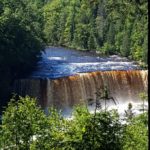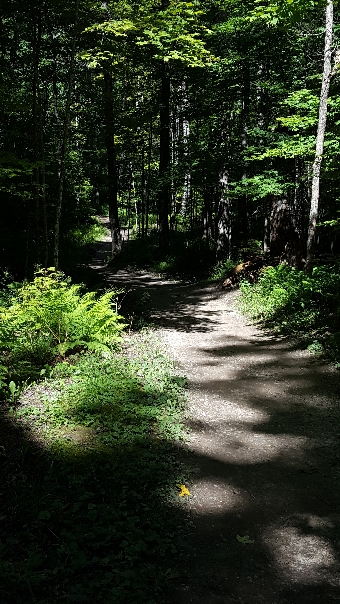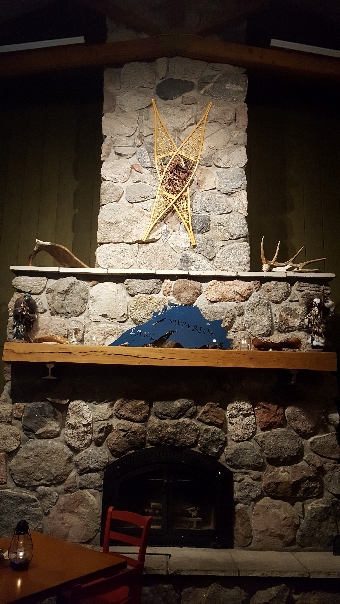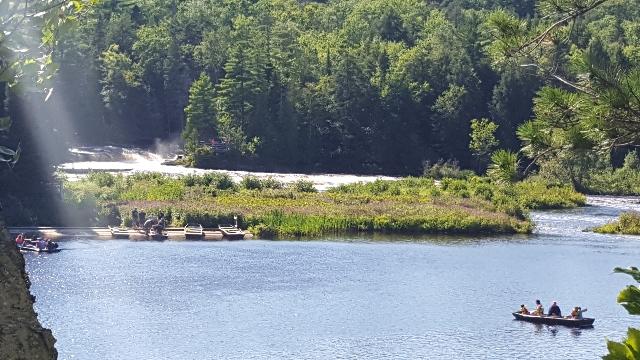 East of the Mississippi, there’s Niagara Falls, then there’s Cohoes Falls and finally there’s Tahquamenon Falls MI. Close to Lake Superior in the Upper Peninsula of Michigan it is the third largest falls in the Eastern part of the US.
East of the Mississippi, there’s Niagara Falls, then there’s Cohoes Falls and finally there’s Tahquamenon Falls MI. Close to Lake Superior in the Upper Peninsula of Michigan it is the third largest falls in the Eastern part of the US.
In the 1940’s Jack and Mimi Barrett would canoe the river, portaging and camping along the way. The journey in itself was beautiful and peaceful, yet the destination was amazing. They traveled the forested area to reach Tahquamenon Falls, only accessible by water. Today, we have Jack and Mimi to thank for our opportunity to visit the falls without canoeing and portaging.
The falls are made up of two distinct falls – upper and lower. The upper falls are unique in that they are the third most voluminous waterfall east of the Mississippi. The first two, both in New York, are Niagara Falls and Cohoes Falls . Tahquamenon Falls has a flow of approximately 50,000 gallons of water per second, think about that for a minute, wow! It happens in a span of approximately 200 feet across with a drop of fifty feet. You hear the falls long before they come into view. The other unique feature is the color of the falls – amber. The amber color comes from the tannins (tannic acid) from the cedar and hemlock swamps the river passes through on the way to the falls. Because of its color and foaming water, it has been dubbed “Root Beer Falls”. The lower falls are a series of cascades. Maybe not as impressive as the upper falls yet just as beautiful.
Why do we have the Barretts to thank? Jack Barrett was a logger with 32 camps. When the property surrounding the falls became available for sale, he purchased it. They knew eventually they wanted the public to enjoy the falls and the wilderness surrounding them as much as they did. A road was built and the Barretts donated the land to Michigan’s Department of Natural Resources for a State Park. One of the stipulations was the road must terminate ¾ of a mile before the falls. They wanted the natural beauty of the area preserved.
If Jack Barrett would have built a logging camp in this area, it would have been Camp 33. In 1950, Camp 33 was built as a logging camp replica. It served as an eating and resting place for the many who would visit the area. In 1990, the Barrett’s grandchildren rebuilt Camp 33. Today it is a Brewery and Pub.
While the Barretts made the land and falls accessible to all, Longfellow first made the falls famous. In his poem of 1855, “The Song of Hiawatha”, he writes Hiawatha built his canoe “by the rushing Tahquamenaw”.
The walk to the falls is an easy one from the parking area. The area sang to our souls and the natural beauty was amazing. The sound of the crashing water could lull anyone to sleep. Watching the water crash and cascade we could only imagine what the Barretts felt the first time they transversed the area and how Longfellow was inspired by the Native American lore.






I am a 78 year old Michigan native that has retired in Texas. I first visited the Tahquamenon Falls in the early 1950’s with my family, when there was no paved roads in that area. This is the first time I have ever heard the falls referred to as “The Root Beer Falls”. Where did that come from?
Hi Gordon,
Thank you for visiting our blog. It must have been something to see the falls in a true natural setting. I do not know when the falls were given the name “Root Beer Falls”.
Laurie